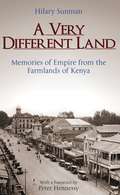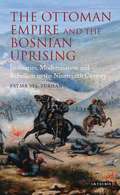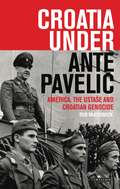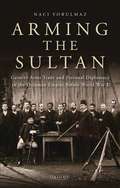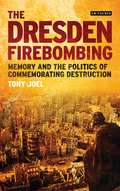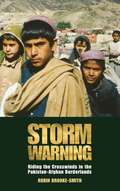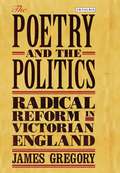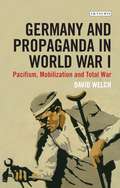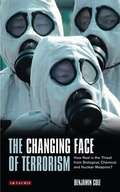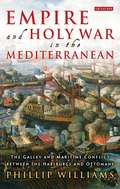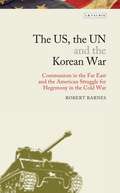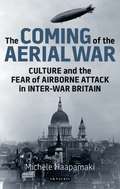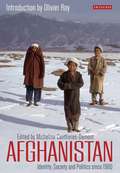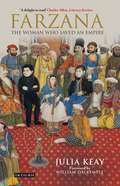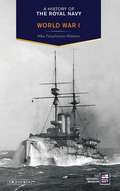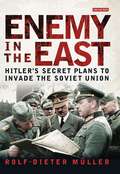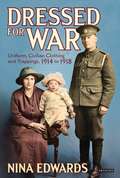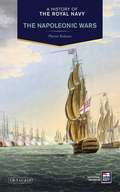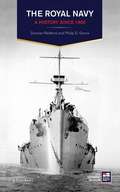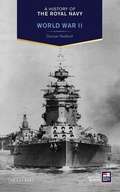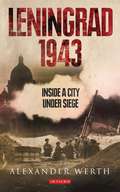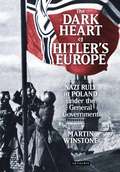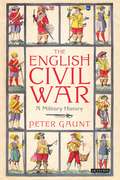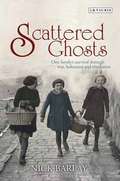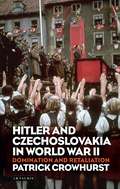- Table View
- List View
A Very Different Land: Memories of Empire from the Farmlands of Kenya
by Hilary SunmanKenya was a 'very different land' for the young officers who went out to Africa to use their technical and professional skills in the early twentieth century. Many such officers were destined for the Colonial Agricultural Service where Hilary Sunman's father, Owen, served from 1928-1950. In this book, Sunman considers the day-to-day experience of 'colonial service', and its many challenges, as she weaves together a human and family story, with special emphasis on her father and his work, combined with her own experiences as a development economist. All the elements - political and developmental - in late colonial policy are present, from the problems of the 'White Highlands' and race to the varying quality of colonial leadership and the rise of the Mau Mau. This book provides a unique and moving account of a country in transition and the pivotal roles played by those on the ground in the final years of empire.
The Ottoman Empire and the Bosnian Uprising: Janissaries, Modernisation and Rebellion in the Nineteenth Century (Library of Ottoman Studies #Vol. 34)
by Fatma Sel TurhanBosnia enjoyed a special status within the Ottoman Empire. Many of the empire's 'janissaries', an elite military stratum of soldiers and nobleman, hailed from this Balkan region. So when Sultan Mehmet II abolished this warrior class in 1826, and this curtailed the regions access to influence in Constantinople, Bosnia rebelled. Under the leadership of Husein Gradaš?evi?, the 'dragon of Bosnia', the kingdom declared independence and waged war with the Ottoman Empire. For the first time, Fatma Sel Turhan illuminates a period of crucial importance to the Balkan regions. She argues convincingly that the uprising was a response to Ottoman moves towards modernisation designed to save the Ottoman Empire from decline, but which eventually led to its demise. She assesses how far the uprising can be considered a nationalist movement, who the rebels were, and how the central authorities dealt with and punished the perpetrators. The Ottoman Empire and the Bosnian Uprising is a major fresh contribution to our understanding of the late Ottoman world and the history of the Balkans.
Croatia Under Ante Pavelic: America, the Ustase and Croatian Genocide in World War II (International Library of Twentieth Century History)
by Robert B. McCormickAnte Pavelic was the leader of the fascist party of Croatia (the Ustaše), who, on Adolf Hitler's instruction, became the leader of Croatia after the Nazi invasion of 1941. Paveli? was an extreme Croatian nationalist who believed that the Serbian people were an inferior race - he would preside over a genocide that ultimately killed an estimated 390,000 Serbs during World War II. Croatia under Ante Paveli? provides the full history of this period, with a special focus on the United States' role in the post-war settlement. Drawing on previously unpublished documents, Robert McCormick argues that President Harry S. Truman's Cold War priorities meant that Paveli? was never made to answer for his crimes. Today, the Ustaše remains difficult legacy within Croatian society, partly as a result of Paveli?' political life in exile in South America. This is a new account of US foreign policy towards one of the Second World War's most brutal dictators and is an essential contribution to Croatian war-time history.
Arming the Sultan: German Arms Trade and Personal Diplomacy in the Ottoman Empire Before World War I (Library of Ottoman Studies)
by Naci YorulmazAt the beginning of the nineteenth century, the Ottoman armaments trade was entirely self-sufficient. But by the end of the century, it was almost entirely under German control. How did Germany under Chancellor Bismarck manage to conquer what had until then been an extremely competitive military market? Focusing on the reign of Sultan Abdülhamid between 1876 and 1909, Naci Yorulmaz's book explores the determining factors that influenced the development of the Ottoman armaments market. While acknowledging the importance of political and economic factors, Arming the Sultan concentrates on the personal relationships which shaped the development of the arms trade, including the bonds between arms-makers and the government, between German politicians and Ottoman grandees, and even the private relationships between Kaiser Wilhelm I, Otto von Bismarck and the Sultan. Yorulmaz's innovative book suggests that the value of these relationships has been overlooked, and ensured German success over British, French and American competition.
The Dresden Firebombing: Memory and the Politics of Commemorating Destruction (International Library Of Twentieth Century History Ser.)
by Tony JoelThe firebombing of Dresden marks the terrible apex of the European bombing war. In just over two days in February 1945, over 1,300 heavy bombers from the RAF and the USAAF dropped nearly 4,000 tonnes of explosives on Dresden's civilian centre. Since the end of World War II, both the death toll and the motivation for the attack have become fierce historical battlegrounds, as German feelings of victimhood compete with those of guilt and of loss. The Dresden bombing was used by East Germany as a propaganda tool, and has been re-appropriated by the neo-Nazi far right. Meanwhile the rebuilding of the Frauenkirche - the city's sumptuous 18th century church destroyed in the raid - became central to German identity, while in London, a statue of the Commander-in-Chief of RAF Bomber Command, Sir Arthur Harris, has attracted protests. In this book, Tony Joel focuses on the historical battle to re-appropriate Dresden, and on how World War II continues to shape British and German identity some seventy years later.
Storm Warning: Riding the Crosswinds in the Pakistan-Afghan Borderlands
by Robin Brooke-SmithThe Afghan-Pakistan Borderlands are pivotal to international security. They are often dangerous, strategically crucial and little explored by outsiders. Robin Brooke-Smith provides a new perspective on Northwest Pakistan in this first-hand account of his years in this troubled region. Tracing the build-up to 9/11 and the upheaval that has followed, this is a captivating behind-the-scenes look into the regional fulcrum of global jihad.Recounting his experiences as Principal of the prestigious Edwardes College in Peshawar, the author explores the creation and growing influence of the Taliban and other extremist groups, and the complicity of the military in their development. Brooke-Smith provides a unique and close-up view into this fascinating area, from personal dealings with senior figures in the notorious ISI Military Intelligence, to giving a voice to the young people of Peshawar. An enthralling and distinctive analysis on the state of the borderlands – and its possible future – this book is illuminating reading for all those interested in Pakistan, Afghanistan and the turbulent recent history of the 'AfPak' region.
The Poetry and the Politics: Radical Reform in Victorian England (Library of Victorian Studies)
by Gregory James James GregoryThe nineteenth century was a time of 'movements' – political, social, moral reform causes – which drew on the energies of men and women across Britain. Radical reform at the margins of early Victorian society is studied by James Gregory in this book, focused on decades of particular social, political and technological ferment: when foreign and British promoters of extravagant technologically-assisted utopias could attract many hundreds of supporters of limited means, persuaded to escape grim conditions by emigration to South America; when pioneers of vegetarianism joined the ranks of the temperance movement; and when working-class Chartists, reviving a struggle for political reform, seemed to threaten the State for a brief moment in April 1848. Through the forgotten figure of James Elmslie Duncan, 'shabby genteel' poet and self-proclaimed 'Apostle of the Messiahdom,' The Politics and the Poetry considers themes including poetry's place in radical culture, the response of pantomime to the Chartist challenge to law and order, and associations between madness and revolution. Duncan became a promoter of the technological fantasies of John Adolphus Etzler, a poet of science who prophesied a future free from drudgery, through machinery powered by natural forces. Etzler dreamed of crystal palaces: Duncan's public freedom was to end dramatically in 1851 just as a real crystal palace opened to an astonished world.In addition to Duncan, James Gregory also introduces a cast of other poets, earnest reformers and agitators, such as William Thom the weaver poet of Inverury, whose metropolitan fêting would end in tragedy; John Goodwyn Barmby, bearded Pontiffarch of the Communist Church; a lunatic 'Invisible Poet' of Cremorne pleasure gardens; the hatter from Reading who challenged the 'feudal' restrictions of the Game Laws by tract, trespass and stuffed jay birds; and foreign exotics such as the German-born Conrad Stollmeyer, escaping the sinking of an experimental Naval Automaton in Margate to build a fortune as the Asphalt King of Trinidad. Combining these figures with the biography of a man whose literary career was eccentric and whose public antics were capitalised upon by critics of Chartist agitation, this book will be essential reading for anyone interested in radical reform and popular political movements in Victorian Britain.
Germany and Propaganda in World War I: Pacifism, Mobilization and Total War
by David WelchAdolf Hitler, writing in Mein Kampf, was scathing in his condemnation of German propaganda in World War I, declaring that Germany failed to recognise that the mobilization of public opinion was a weapon of the first order. This, despite the fact that propaganda had been regarded by the German leadership, arguably for the first time, as an intrinsic part of the war effort. In this book, David Welch fully examines German society - politics, propaganda, public opinion and total war - in the Great War. Drawing on a wide range of sources - posters, newspapers, journals, film, Parliamentary debates, police and military reports and private papers - he argues that the moral collapse of Germany was due less to the failure to disseminate propaganda than to the inability of the military authorities and the Kaiser to reinforce this propaganda, and to acknowledge the importance of public opinion in forging an effective link between leadership and the people.'This is the most important book about German information policy, including censorship, 1914-18, ever written.' - David Culbert, Professor of History, Louisiana State University'...[an] extraordinarily wide-ranging, intelligent and authoritative study...an outstanding piece of historical scholarship.' - Nicholas Reeves, Historical Journal of Film, Radio and Television
The Changing Face of Terrorism: How Real is the Threat from Biological, Chemical and Nuclear Weapons?
by Benjamin ColeChemical, Biological, Radiological and Nuclear (CBRN), terrorism and the 'war on terror' are major features of international relations and global concern. Terrorist threats and actual violence have become increasingly dangerous and lethal since the 1970s. However, the attacks on the World Trade Center and the Pentagon on 11 September 2001 heralded a new era in terrorist action and were the culmination of a terror campaign against American targets world-wide. 'The Changing Face of Terrorism' evaluates the continuing threat and counter-measures since 9/11 and into the 21st century. It is a sober and measured evaluation of the CBRN threat and argues that continuing terror attacks are inevitable and the 'war on terror' will be a continuing feature in international politics and military action. Benjamin Cole shows how effective counter-terrorist measures must be measured and based not only on effective police and military intelligence and action but on careful evaluation of the politics, motivations, scientific and technical abilities of groups - no terrorist group has made a nuclear device - and religious and personal motivation.
Empire and Holy War in the Mediterranean: The Galley and Maritime Conflict between the Habsburgs and Ottomans (International Library of Historical Studies)
by Phillip WilliamsIn the century after 1530 the empires of the Habsburgs of Spain and the Ottoman Turks fought a maritime war that seemed destined to lead nowhere:: lasting peace was as unlikely as final triumph, in part because the salient feature of this conflict was a violent form of piracy practiced by the 'corsairs' of North African and Malta. It was fundamentally a war of unequal means, since the Habsburgs of Spain had too few good warships and the Ottomans too many bad ones. Christendom and Islam engaged in a war fought largely through the exercise of private violence: the Hospitaller Knights of Malta and ghazi captains of North Africa succeeded in imposing their crusading ethos on the Mediterranean.If a degree of futility loomed over these campaigns, it was nevertheless true that the Mediterranean witnessed a sustained conflict which in scale and intensity was far greater than that of any contemporary form of warfare at sea. Moreover the sea was never abandoned as, until at least 1620, large galley fleets continued to patrol the inland sea. The raiding methods employed by Elizabethan 'seadogs' like Sir Francis Drake would certainly not have worked in this theatre of arms, as the defences in Italy and North Africa were much more formidable than those of the Atlantic.Phillip Williams begins with a detailed examination of the oared warships used in these campaigns. He then explores the structures of political and military organization and the role of geography and the environment in shaping the fighting; stressing that the Italian territories were of vital significance to the Habsburgs of Spain. He considers the cultural and historical outlook of protagonists such as the Habsburg rulers Charles V and Philip II and the Ottoman Sultan Süleyman the Magnificent, examining the extent to which the dictates of prudence triumphed over ideals of performing 'the service of God'. Providing a unique perspective on early modern maritime conflict, this book will be essential reading for all students and researchers of Mediterranean History and the early modern world.
The US, the UN and the Korean War: Communism in the Far East and the American Struggle for Hegemony in the Cold War (Library of Modern American History)
by Robert BarnesMilitary, social and economic historians have long appreciated the significance of the conflict in Korea in shaping the post-war world. The policy of containment was formed, China was established as an important military power, and the US increased its military expenditure fourfold as a result of a conflict which killed over 33,000 Americans. What has been less appreciated is the role played by the United Nations and the British Commonwealth in influencing US strategy at this time of crisis: the Truman administration invested time and effort into gaining UN approval for the conflict in Korea, and the course of the war was adapted to keep UN allies, often holding crucial strategic positions in other Cold War theatres, in tow. This groundbreaking study explores these fluctuating relationships, the tensions between Washington and its British Commonwealth allies and their impact on the development of the conflict, from its outbreak in 1950 to its end at the Geneva Conference of 1954. Robert Barnes reframes the Korean War for the first time in the context of a United States less dominant than is usually imagined. This will be essential reading for students of International Relations, Cold War Studies and modern History.
The Coming of the Aerial War: Culture and the Fear of Airborne Attack in Inter-War Britain (International Library of Twentieth Century History)
by Michele HaapamäkiIn the first half of the 20th century the possibility of flight opened up entirely new avenues of thought and exploration. In the age of H.G. Wells and Biggles, the opening up of the air to balloons and planes - the Royal Flying Corps was founded in 1912 - appealed to concepts of courage and bravery which would be both encouraged and undermined by the experiences of World War I. The sky also held new terrors for everyday people who were now within reach of an airborne enemy - these fears included the possibilities of bombing, poison gas, surveillance and social control. This duality of fear and enthusiasm drove the Air Raid Precaution movement, while vocal elements in the press and in parliament called for radical plans to cope with apocalyptic scenarios. Here, Michele Haapamäki charts the history of flight and of war in the air in the early 20th century, addressing the key issues of interwar historiography such as patriotism, fear, masculinity and propaganda.
Afghanistan: Identity, Society and Politics Since 1980 (Library of Modern Middle East Studies #20150213)
by Roy Olivier Micheline Centlivres-DemontOver the last three decades Afghanistan has been plagued by crisis from Soviet invasion in 1979 and Taliban rule to US invasion following the events of 9/11. Here the top specialists on Afghanistan, including Olivier Roy, Ahmad Rashid and Jonathan Goodhand, provide a unique overview of the evolution, causes and future of the Afghan crisis. While much has been written about the problems in Afghanistan, this book also explores the unprecedented transformation of Afghan society, paying close attention to the country's cultural heritage. With varied perspectives from the fields of politics, history, science, economics, anthropology, musicology, art history and architecture, Centlivres-Demont sheds new light on the development and perception of Afghanistan over the past 30 years. Covering political and military events and examining the role of ethnic groups, religious and ideological factors and the role of the leaders and war chiefs of the period from the anti-Soviet resistance to the presidency of Hamid Karzai this book will prove essential reading to all interested in Afghanistan and the wider Middle East region. Examining recent events in the light of the country's economy, Afghan civil society and state reconstruction attempts, this is a comprehensive and diverse look at a country whose recent history has been marked by internal conflicts and foreign intervention.
Farzana: The Woman Who Saved an Empire
by Julia KeayAmongst the riches of 19th century India, as the British fought their way across Mughal territory, an orphaned street-girl is brought to court to perform for the Emperor. That girl was Farzana, and she would become a courtesan, a leader of armies, a treasured defender of the last Mughal emperor and the head of one of the most legendary courts in history. In this beautifully written book, the author's last, Julia Keay weaves a story which spans the Indian continent and the end of a golden era in Indian history, the story of a nobody who became a teenage seductress and died one of the richest and most prominent woman of her age. Farzana rode into battle atop a stallion, though only 4 ½ feet tall, and led an army which defended a sickly Mughal empire. She dabbled in witchcraft while gaining favour with the Pope, and died a favourite of the British Raj. Farzana is an evocative and moving depiction of one of the most remarkable, and least-known, historical lives of the 19th century.
A History of the Royal Navy: World War I (A History of the Royal Navy)
by Mike Farquharson-RobertsFor many years the naval warfare of World War I has been largely overlooked; yet, at the outbreak of that war, the British Government had expected and intended its military contribution to the conflict to be largely naval. Britain was not simply defending an island; it was defending a far flung empire. Without the navy such an undertaking would have been impossible. Following the naval arms race in the early 20th century, both Britain and Germany were equipped with the latest naval technology, including revolutionary new vessels such as dreadnoughts and diesel-powered submarines. Although the Royal Navy's operations in World War I were global, most of the fleet's strength was concentrated in the Grand Fleet, which confronted the German High Seas Fleet across the North Sea. At the Battle of Jutland in 1916 the Royal Navy, under the command of Admiral Jellicoe, fought an iconic, if inconclusive battle for control of shipping routes. 43,244 Royal Navy personnel lost their lives fighting on the seas in World War I. This book tells their story and places the navy back at the heart of the British war effort.
Enemy in the East: Hitler's Secret Plans to Invade the Soviet Union
by Rolf-Dieter MüllerOperation Barbarossa, Hitler's invasion of the Soviet Union in 1941, led to one of the most brutal campaigns of World War II: of the estimated 70 million people who died in World War II, over 30 million died on the Eastern Front. Although it has previously been argued that the campaign was a pre-emptive strike, in fact, Hitler had been planning a war of intervention against the USSR ever since he came to power in 1933. Using previously unseen sources, acclaimed military historian Rolf-Dieter Müller shows that Hitler and the Wehrmacht had begun to negotiate with Poland and had even considered an alliance with Japan soon after taking power. Despite the signing of the Molotov-Ribbentrop Pact, at the declaration of war in September 1939, military engagement with the Red Army was still a very real and imminent possibility. In this book, Müller takes us behind the scenes of the Wehrmacht High Command, providing a fascinating insight into an unknown story of World War II.
Dressed for War: Uniform, Civilian Clothing and Trappings, 1914 to 1918
by Nina EdwardsMen in khaki and grey squatting in the trenches, women at work, gender bending in goggles, with overalls on over their trousers. What people wear matters. Well illustrated, this book tells the stories of what people on both sides wore on the front line and on the home front through the seismic years of World War I. Nina Edwards reveals fresh aspects of the war through the prism of the smallest details of personal dress, of clothes, hair and accessories, both in uniform and civilian wear. She explores how, during a period of extraordinary upheaval and rapid change, wearing a certain perfume, say, or the just-so adjustment to the tilt of a hat offer insights into the individual experience of men, women and children during the course of World War I.
A History of the Royal Navy: Napoleonic Wars (A\history Of The Royal Navy Ser.)
by Martin RobsonThe French Revolutionary and Napoleonic Wars were the first truly global conflicts. The Royal Navy was a key player in the wars and the key enabler of British success - at the cessation of hostilities Britain emerged as the only power capable of sustained global hegemony based on maritime and naval strength. The most iconic battles of any era were fought at sea - from the Battle of the Nile in 1798 to Nelson's momentous victory at Trafalgar in October 1805. This book looks at the history of the Royal Navy during the French Revolutionary and Napoleonic Wars from a broad perspective, examining the strategy, operations and tactics of British seapower. While it delves into the details of Royal Navy operations such as battle, blockade, commerce protection and exploration, it also covers a myriad of other aspects often overlooked in narrative histories including the importance of naval logistics, transport, relations with the army and manning. An assessment of key naval figures and combined eyewitness accounts situate the reader firmly in Nelson's navy. Through an exploration of the relationship between the Navy, trade and empire, Martin Robson highlights the contribution the Royal Navy made to Britain's rise to global hegemony through the nineteenth century Pax Britannica.
The Royal Navy: A History Since 1900 (A History of the Royal Navy)
by Duncan Redford Philip D. GroveSince 1900, the Royal Navy has seen vast operational changes. This book tells the story, not just of victory and defeat, but also of how the Navy has adjusted to a century of rapid technological and social change. The extensive reforms made by Admiral Fisher at the dawn of the twentieth century saw the navy's nineteenth-century wooden fleet replaced with the latest modern technology - battleships (including the iconic dreadnoughts), aircraft carriers and submarines. In World War I and World War II, the navy played a central role, with unrestricted submarine warfare and supply blockades becoming an integral part of combat. However it was the development of nuclear and missile technology during the Cold War era which drastically changed the face of naval warfare - today the navy can launch sea-based strikes across thousands of miles to reach targets deep inland. This book places the wars and battles fought by the navy - from Jutland to the Falklands - within a wider context, looking at political, economic, social and cultural issues, as well as providing a thorough operational history.
A History of the Royal Navy: World War II (A\history Of The Royal Navy Ser.)
by Duncan RedfordThe Royal Navy's operations in World War II started on 3 September 1939 and continued until the surrender of Japan in August 1945 - there was no 'phoney war' at sea. The navy played a central role in the evacuation of the retreating British army at Dunkirk, and later orchestrated the sinking of Germany's mighty battleship and Hitler's pride, the Bismarck. Without the Royal Navy's attention to the defence of Britain's seaborne trade - especially in the struggle against German U-boats in the Battle of the Atlantic - there would not have been food for the country, fuel for the RAF's operations or supplies to keep the army fighting in Europe, North Africa and the Far East. Yet the outstanding naval contribution to Britain's survival and eventual victory came at a heavy cost in terms of ships and to the men who had to face not just the violence of the enemy, but also the violence of the sea. This book argues that World War II was, effectively, a maritime war; it was the Royal Navy's war
Leningrad 1943: Inside a City Under Siege
by Alexander WerthThe 900-day German Siege of Leningrad is the most powerful testimony to the immeasurable cruelty and horror of World War II. As the sole British correspondent to have been in the city during the blockade, Alexander Werth presents a harrowing firsthand account of the savagery and destruction wrought by the Nazis against the civilian population of the city. His writing evokes compelling images of terror – the bombing of children's hospitals, mass starvation and cannibalism – with rich and well-informed first hand-accounts and commentary on the internal politics of Soviet party chiefs, soldiers and civilian resistance fighters. Both an authoritative historical document and a journalistic narrative of the overwhelming sadness, grief and futility of 20th century warfare, this is an invaluable look at one of the greatest losses of human life in recorded history.
The Dark Heart of Hitler's Europe: Nazi Rule in Poland Under the General Government
by Martin WinstoneAfter the German and Soviet attack on Poland in 1939, vast swathes of Polish territory, including Warsaw and Kraków, fell under Nazi occupation in an administration which became known as the 'General Government'. The region was not directly incorporated into the Reich but was ruled by a German regime, headed by the brutal and corrupt Governor General Hans Frank. This was indeed the dark heart of Hitler's empire. As the principal 'racial laboratory' of the Third Reich, it was the site of Aktion Reinhard, the largest killing operation of the Holocaust, and of a campaign of terror and ethnic cleansing against Poles which was intended to be a template for the rest of eastern Europe. This book provides a thorough history of the General Government and the experiences of the Poles, Jews and others trapped in its clutches. Employing previously underused sources, Martin Winstone provides a unique insight into the occupation regime which dominated much of Poland during World War II.
The English Civil War: A Military History
by Peter GauntSir, God hath taken away your eldest son by a cannon shot. It brake his leg. We were necessitated to have it cut off, whereof he died.' In one of the most famous and moving letters of the Civil War, Oliver Cromwell told his brother-in-law that on 2 July 1644 Parliament had won an emphatic victory over a Royalist army commanded by King Charles I's nephew, Prince Rupert, on rolling moorland west of York. But that battle, Marston Moor, had also slain his own nephew, the recipient's firstborn. In this vividly narrated history of the deadly conflict that engulfed the nation during the 1640s, Peter Gaunt shows that, with the exception of World War I, the death-rate was higher than any other contest in which Britain has participated. Numerous towns and villages were garrisoned, attacked, damaged or wrecked. The landscape was profoundly altered. Yet amidst all the blood and killing, the fighting was also a catalyst for profound social change and innovation. Charting major battles, raids and engagements, the author uses rich contemporary accounts to explore the life-changing experience of war for those involved, whether musketeers at Cheriton, dragoons at Edgehill or Cromwell's disciplined Ironsides at Naseby (1645).
Scattered Ghosts: One Family's Survival through War, Holocaust and Revolution
by Nick BarlayWhen two Hungarian Jewish refugees landed by accident in Britain in the winter of 1956, they had little idea what the future would hold. But they carried with them the traces of their turbulent past, just enough to provide the clues to their past. Scattered Ghosts combines memoir, investigation and travel to resurrect 200 years of wars and revolutions, from the Austro-Hungarian Empire via two totalitarianisms to contemporary Britain. It is the story of an all but disappeared world told through the eyes of a single family ruptured by great forces, and occasionally brought together by cherry strudel.Through haphazard and fragmented possessions - a blunt-pencilled letter; a final photograph; a hastily typed certificate; a protecting document; a farewell postcard from a distant place; a recipe - Nick Barlay retraces the footsteps of the vanished. There is the death march of a grandfather, the military manoeuvres of a great uncle, the final weeks and moments of a great grandmother deported to Auschwitz, two boys' survival of an untold massacre, and codenamed spies operating in Cold War Britain. The ordinary mysteries and emotional legacies still resonate today in the parallel lives of far-flung family members. Diaspora, division and cultural identity form the backdrop to the story of ancestors who walked barefoot from Eastern Europe to experience Communism and Nazism, and to outlive them both. Scattered Ghosts is a family history that explores the events, great and small, on which a family's existence hinges. How did one person survive and another die? How did a Soviet tank shell cause a revolution between sisters? How did two refugees escape an invading army? Where did successive generations end up? And, ultimately, where did the recipe for cherry strudel come from?
Hitler and Czechoslovakia in World War II: Domination and Retaliation
by Patrick CrowhurstThe invasion of Czechoslovakia by Nazi Germany in March 1939 helped to precipitate Europe's descent into World War II six months later. The move, supposedly to protect the Sudeten Germans, shocked many in Europe, who saw it as a clear statement of intent by Hitler. Here, Patrick Crowhurst argues that occupation of the Sudetenland and the Czech lands was also crucial to the Nazi war machine. The armaments, factories and raw materials that Hitler seized accelerated Germany's capabilities; Czech tanks would prove crucial in the Ardennes and, as the Wehrmacht fought at Stalingrad, Armaments Minister Albert Speer was corralling Czech industrial machinery to produce engines, aircraft and equipment in support. New Slovakian and Czech primary material also provides the first in-depth account of the German reaction to the assassination of Reinhardt Heydrich on the streets of Prague in June 1942, and Hitler's plans for the genocide of Czech Jewry. Hitler and Czechoslovakia in World War II will be of great interest to historians of World War II, Czechoslovakia and Nazi Germany.
